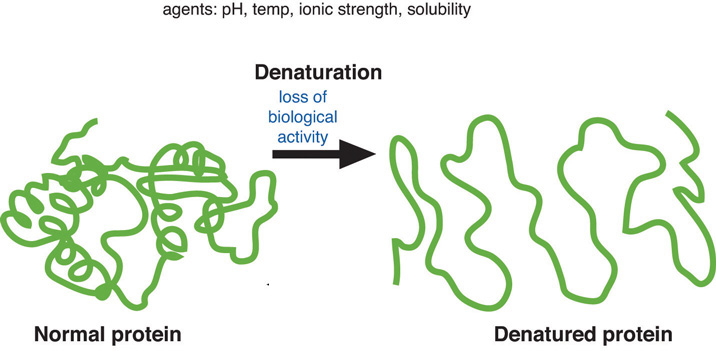The Role of Proteins in Foods: Cooking and Denaturation
In addition to having many vital functions within the body, proteins perform different roles in our foods by adding certain functional qualities to them. provides food with structure and texture and enables water retention. For example, proteins foam when agitated. (Picture whisking egg whites to make angel food cake. The foam bubbles are what give the angel food cake its airy texture.) Yogurt is another good example of proteins providing texture. Milk proteins called caseins coagulate, increasing yogurt’s thickness. Cooked proteins add some color and flavor to foods as the amino group binds with carbohydrates and produces a brown pigment and aroma. Eggs are between 10 and 15 percent protein by weight. Most cake recipes use eggs because the egg proteins help bind all the other ingredients together into a uniform cake batter. The proteins aggregate into a network during mixing and baking that gives cake structure.

Protein Denaturation: Unraveling the Fold
When a cake is baked, the proteins are denatured. refers to the physical changes that take place in a protein exposed to abnormal conditions in the environment. Heat, acid, high salt concentrations, alcohol, and mechanical agitation can cause proteins to denature. When a protein denatures, its complicated folded structure unravels, and it becomes just a long strand of again. Weak chemical forces that hold tertiary and secondary protein structures together are broken when a protein is exposed to unnatural conditions. Because proteins’ function is dependent on their shape, denatured proteins are no longer functional. During cooking the applied heat causes proteins to vibrate. This destroys the weak bonds holding proteins in their complex shape (though this does not happen to the stronger ). The unraveled protein strands then stick together, forming an aggregate (or network).

When a protein is exposed to a different environment, such as increased temperature, it unfolds into a single strand of amino acids.
Learning Activities
Technology Note: The second edition of the Human Nutrition Open Educational Resource (OER) textbook features interactive learning activities. These activities are available in the web-based textbook and not available in the downloadable versions (EPUB, Digital PDF, Print_PDF, or Open Document).
Learning activities may be used across various mobile devices, however, for the best user experience it is strongly recommended that users complete these activities using a desktop or laptop computer.
A class of compounds composed of linked amino acids. They contain carbon, hydrogen, nitrogen, oxygen, and sometimes other atoms in specific configurations.
The loss of a protein’s functional three-dimensional structure due to environmental influences such as temperature or pH.
The molecules from which proteins are built, each protein being composed of a specific sequence of linked amino acids.
The chemical linkage between amino acids into the structure of a protein chain.
